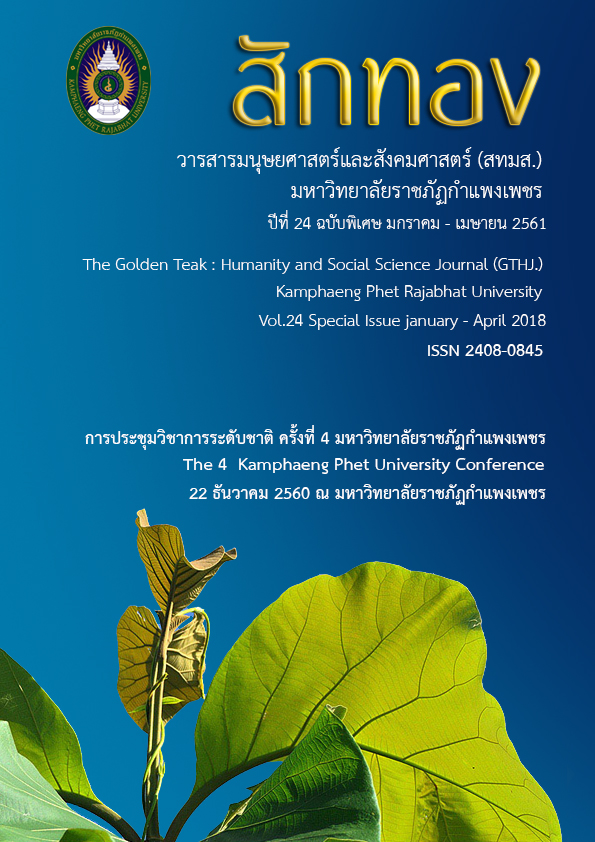The Organizational Commitment of Generation Y Employees of Private Company in a Service Business in Bangkok
Main Article Content
Abstract
The purpose of this research were to 1) study the organizational commitment of Generation Y employees of private company in a service business in Bangkok 2) study the ways to improve the development and organizational commitment of Generation Y employees of private company in a service business in Bangkok. This research was a qualitative research by using Phenomenological Approach. The researcher gathered data by conducting the in-depth interview of 23 Generation Y employees of private company in a service business in Bangkok. The research tool was open-end questions and presented with descriptive analysis. The results showed that organizational commitment of Generation Y employees of private company in a service business in Bangkok. The attitudes and behaviors can be expressed in three aspects; 1) Say is that an employee is proud of working in the organization and have confidence in the organization's policies; 2) Stay is that an employee has a sense of security and safety in the workplace and 3) Strive is the willingness to collaborate with the organization and knowledge and skills that make the job of the organization successful by concepts of Hewitt Aon. It was also found that Generation Y employees of private company in a service business in Bangkok suggested the ways for the organizational commitment while is composed of 9 dimensions: (1) Organization Communication; the organization provides multi-channel communication (2) Leadership is based on participatory management (3) Job characteristics; Job assignments are available challenging to promote more work skills (4) Opportunity to develop knowledge and regularly planned training (5) Security and Progress Determining career advancement that is consistent with knowledge and needs of personnel (6) relationships with colleagues; it should be organized in groups or recreational activities in order to reduce the gap and lead to good working atmosphere (7) Compensation and welfare; Salary based on ability (8) Safe and Hygienic working environment provision of modern and sufficient working facilities and (9) Work-life Balance; there should have annual holiday, health promotion, and recreational activities.
Article Details
บทความที่ได้รับการตีพิมพ์เป็นลิขสิทธิ์ของวารสาร สักทอง : วารสารมนุษยศาสตร์และสังคมศาสตร์ สถาบันวิจัยและพัฒนา มหาวิทยาลับราชภัฏกำแพงเพชร
ข้อคิดเห็นใดๆ ที่ปรากฎในวารสารเป็นวรรณกรรมของผู้เขียนโดยเฉพาะ ซึ่งมหาวิทยาลัยราชภัฏกำแพงเพชรและบรรณาธิการไม่จำเป็นต้องเห็นด้วย
References
Support and Operations Team of Property Care Services (Thailand) Company Limited
(Head Office). Journal Graduate Studies Valaya Alongkorn Rajabhat University,
10(2), 155-164.
Aon Hewitt. (2017). Trends in Global Employee Engagement, Human Resource. [Online].
Available : http://www.aon.com/human-capital-consulting/. [2017, May 13].
Appelbaum, S. H., Serena, M., & Shapiro, B. T. (2005). Generation “X” and the Boomers : An
Analysis Of Realities and Myths. Management Research New, 28(1), 1-33.
Bhatnagar, J. (2007). Talent Management Strategy of Employee Engagement in Indian ITES
Employee : Key to Retention. Employee Relations, 29(6), 640-663.
Denzin, N. K. (1970). Sociological Methods : A source Book. Chicago : Aldine.
Fueangfung, V. (2016, January-April). Affecting TaskPerformancnof Employeeof Civil,
Maemoh Power Plant, Lumpang Province. The Golden Teak : Humanity and Social
Science, 22(1), 178-192.
Gurau, C. (2012). A Life-Stage analysis of Consumer Loyalty Profile : Comparing Generation X
and Millennial Consumers. Journal of Consumer Marketring, 29(2), 103-113.
Institute for Employment Studies (2004). The drivers of employee engagement. [Online].
Available : http://www.employment-studies.co.uk/summary/ summary.php?id=408. [2017, June 25].
Kaewsang, T. & Phasunon, P. (2016, September-December). The Relationships
between Organizational Commitment and Organizational Loyalty of the Staffs
Nongpho Ratchaburi Dairy Cooperative Limited (Under The Royal Patronage).
Veridian-E-Journal, Silpakorn University Humanities, Social Sciences and arts, 9(3),
1260-1274.
Kengkarnchang, K. (2013, January-June). Generation Y and New Challenge in a Human
Resources Administration. Journal of Social Sciences and Liberal Arts Kasetsart
University, 2(1), 15-27.
Lee, C., Mui Hung, D., & Ling, T. (2012). Work Values of Generation Y Preservice Teachers in
Malaysia. Procedia-Social and Behavioral Sciences, 65,704-710.
Lloyd, R. (2008). Discretionary effort and the performance domain. The Australian and New
Zealand Journal of Organization Psychology, 1(1), 22-34.
Phomlarak, W. (2016, May-August). Organizational Climate of he School Districtin Loei
Province. The Golden Teak : Humanity and Social Science, 22(2), 125-134.
Podhisita, C. (2013). The Science and Art of Qualitative Research. (6 th ed.) Bangkok :
Amarin Printing & Publishing.
Saengsai, A. (2015). The Effect of Organizational Factors and Perceived Organizational
Support on Genertion-Y Employees’ Commitment: A Case Study of Aaian
Stanley International Co.,LTD. Master of Business Administration Thesis, General Management Major, Rajamangala University of Technology Thanyaburi.
Soipetch, P. (2014). Employee Engagement: A Case Study of Employees Working
in Telecommunication and Information Technology Company-Engineering
Department in Bangkok. Master of Business Administration Independent Study,
Nation University.
Steers, Richard. M., & Porter, Lyman. W. (1983). Motivation and Work Behavior. (3 rd ed.).
New York : McGraw-Hill.
Suthammanon, L. & Osathanugrah, K. (2015, May-August). Employees Engagement
Model : A Case Study of Bill Payment Service Business XYZ Company Limited.
Panyapiwat Journal, 7(2), 96-107.
Thaivijitsin, S. (2015). Factors Influencing Employees Engagement : A Case Study of Generation Y Employee in Sathorn and Asoke District. Master of Business Administration Thesis, Stamford International University.
Vincent-Hoper, S., Muser, C., & Janneck, M. (2012). Transformational Leadership, Work
Engagement and Occupational Success. Career Development International, 27(7),
663-682.

